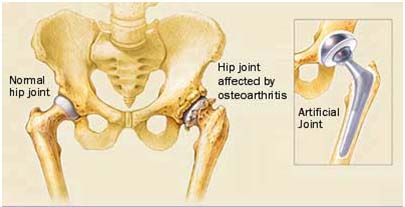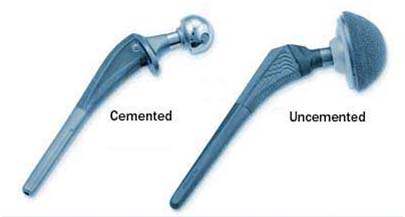Why it's done
The goal of hip replacement surgery is to relieve pain and increase the mobility and function of a damaged hip joint. If a stiff, painful hip joint has forced you to cut back on everyday activities, successful surgery may allow you to resume them.
Before thinking about surgery, though, your doctor may recommend other treatments, such as pain medications, physical therapy, exercise, and using a cane or walker. If these treatments are not enough, hip replacement may be the right option for you.
Conditions that can damage the hip joint, sometimes necessitating hip replacement surgery, include :
- Osteoarthritis
- Rheumatoid arthritis
- Broken hip
- Bone tumor
- Osteonecrosis, which occurs when there is inadequate blood supply to the ball portion of the hip joint
Symptoms
Symptoms that might lead you to consider hip replacement include:
- Pain that keeps you awake at night
- Little or no relief from pain medications or walking aids
- Difficulty walking up or down stairs
- Trouble rising from a seated position
- Having to stop activities you enjoy, such as walking, because you're in too much pain
Risks of Hip Replacement Surgery
Hip replacement surgery is generally safe, but as with any surgery, complications can occur. Although some complications are serious, most can be treated successfully. Complications of hip replacement include :
Blood clots : Clots in your leg veins can form as a result of decreased movement of your leg after surgery, as well as from injury to the veins during surgery. Your doctor usually gives you blood-thinning medications after your surgery to try to prevent clots from forming. Compression devices, such as elastic stockings, and exercise to increase blood flow through the veins in your legs also can reduce your risk.
Infection : Infections can occur at the site of your incision and in the deeper tissue near your new hip. Most infections are treated with antibiotics, but a major infection near your prosthesis may require surgery to remove and replace the prosthesis.
Fracture : During surgery, healthy portions of your hip joint may fracture. Sometimes, the fractures are so small that they heal on their own, but larger fractures may be corrected during surgery with wires, cables or bone grafts.
Dislocation : Certain positions can cause the ball of your new joint to become dislodged. To avoid this, it is often recommended that after surgery you don't bend more than 90 degrees at the hip and don't let your leg cross the midline of your body. If the hip dislocates, your doctor may fit you with a brace to keep the hip in the correct position. If your hip keeps dislocating, surgery is often required to stabilize it.
Loosening : Over time your new joint may loosen, causing pain in your hip. Surgery might be needed to fix the problem.
Breakage of the prosthesis : Though rare, your artificial hip can break several years after surgery. Another surgery would be required to replace the broken joint.
Change in leg length : Your surgeon takes steps to avoid the problem, but occasionally your new hip may make your leg longer or shorter than the other one. Sometimes this is caused by weakness in the muscles surrounding your hip, also placing the hip at risk of dislocation. In this case, progressively strengthening and stretching those muscles can make it more stable.
Joint stiffening : Sometimes the soft tissues around your joint harden (called ossification), making it difficult to move your hip. This usually isn't painful. If you're at risk of ossification, your doctor may recommend medications or radiation therapy to prevent it from happening.
Wear and tear over time : Your prosthetic hip joint may wear out eventually, so if you have hip replacement surgery when you're relatively young and active, you may need a second hip replacement within your lifetime. However, new materials are making implants last longer, so a second replacement may not be needed for many years.
How you prepare
Before surgery you'll meet with your orthopedic surgeon for an examination.
The surgeon will :
- Ask about your medical history and current medications
- Do a brief general physical examination to make sure you're healthy enough to undergo surgery
- Examine your hip, paying attention to the range of motion in your joint and the strength of the surrounding muscles
- Order blood tests, an X-ray and possibly an MRI
This preoperative evaluation is a good opportunity for you to ask questions about the procedure. If you have any concerns about the surgery, be sure to ask.
Your doctor or surgeon may also recommend that you begin an exercise program in preparation for your surgery. Some doctors believe that people who have an established muscle-building and flexibility program before surgery have better outcomes and faster recovery time following surgery. Preoperative exercise programs may have less effect in those with advanced osteoarthritis, however. Talk to your doctor before starting any exercise program.
What to expect from Hip Replacement Surgery
Artificial hip

Hip prostheses are designed to mimic the ball-and-socket action of your hip joint. During hip replacement surgery, your surgeon removes the diseased or damaged parts of your hip joint and inserts the artificial joint.
Two types of hip implants

Cemented implants are held in place with bone cement. Uncemented implants have textured surfaces that allow new bone to grow into the implant, securing it in place.
When you check in for your surgery, you'll be asked to remove your clothes and put on a hospital gown. The first member of the medical team to visit may be the anesthesiologist. You'll be given either general anesthesia or a spinal block, which numbs the lower half of your body.
Because infection and blood clots are possible complications of hip replacement surgery, your surgeon may order preventive medications — antibiotics and blood thinners — to be given before the surgery begins.
During the procedure of Hip Replacement
First, the surgeon will make an incision over the side of your hip, through the layers of tissue. Diseased and damaged bone and cartilage are removed, leaving healthy bone intact. Next, the prosthetic socket is implanted into your pelvic bone to replace the damaged socket. Then, the surgeon replaces the round top of your femur with the prosthetic ball, which is attached to a stem that fits into your thighbone. Your new, artificial joint is designed to mimic the natural, gliding motion of a healthy hip joint.
In recent years, various techniques have evolved for performing hip replacements. Some of these techniques are referred to as minimally invasive hip replacements, although this can refer to many different types of hip replacement procedures. The hope is that less invasive techniques reduce the recovery time and pain compared with standard hip replacements. However, studies comparing the outcomes of standard hip replacement with those of minimally invasive hip replacement have had mixed results. All hip replacement surgeries have benefited from newer anesthetic techniques that result in better pain management, speeding the traditional recovery time.
After the procedure of Hip Replacement
After surgery, you'll be moved to a recovery area for a few hours while your anesthesia wears off. Nurses or other anesthesia aides will watch your blood pressure, pulse, alertness, pain or comfort level, and your need for medications.
Blood clot prevention
After your surgery, you'll be at increased risk of blood clots in your legs. Possible measures to prevent this complication include :
Early mobilization : You'll be encouraged to sit up and even try walking with crutches or a walker as soon after surgery as possible, usually after one day of recovery.
Pressure application : Both during and after surgery, you may wear elastic compression stockings or inflatable air sleeves similar to a blood pressure cuff on your lower legs. The pressure exerted by the inflated sleeves helps keep blood from pooling in the leg veins, reducing the chance that clots will form.
Blood-thinning medication : Your surgeon may prescribe an injected or oral blood thinner after surgery. Depending on how soon you walk, how active you are and your overall risk of blood clots, you may need blood thinners for several more weeks after surgery.
Physical therapy
A physical therapist may help you with some exercises that you can do in the hospital and at home to speed recovery.
Activity and exercise must be a regular part of your day to regain the use of your joint and muscles. Your physical therapist will recommend strengthening and mobility exercises and will help you learn how to use a walking aid, such as a walker, a cane or crutches. As therapy progresses, you'll gradually increase the weight you put on your leg until you're able to walk without assistance.
Home recovery and follow-up care
Before you leave the hospital, you and your caregivers will get tips on caring for your new hip. For a smooth transition :
- Arrange to have a friend or relative prepare some meals for you
- Place everyday items at waist level, so you can avoid having to bend down or reach up
- Consider making some modifications to your home, such as getting a raised toilet seat
About six to eight weeks after surgery, you'll have a follow-up appointment with your surgeon to make sure your hip is healing properly. If recovery is progressing well, most people resume their normal activities by this time — even if in a limited fashion.
Results of Hip Replacement
Hip replacement surgery is successful more than 90 percent of the time.
Expect your new hip joint to reduce the pain you felt before your surgery and increase the range of motion in your joint. But don't expect to do anything you couldn't do before surgery. High-impact activities — such as running or playing basketball — may never get your doctor's approval. But in time, you may be able to swim, play golf, walk or ride a bike comfortably.






